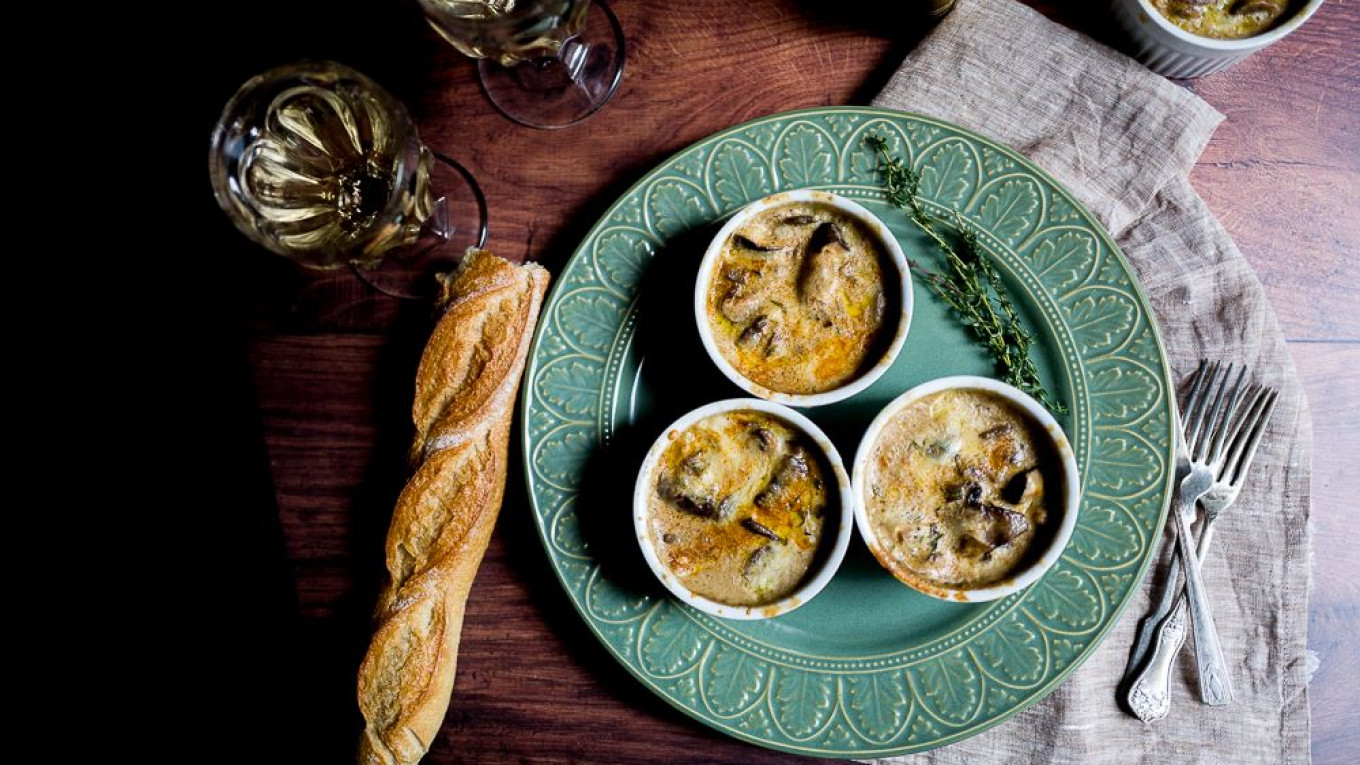Mushroom season continues its stately autumnal progress. Having stocked the freezer with mushroom soup, mushroom lasagna, and mushroom pâté, I suddenly remembered that most quintessentially mushroom-y dish of them all; one I’m guessing none of us has enjoyed in quite some time: Mushroom Julien.
This fixture of glitzy Soviet-era restaurants and theater buffets is another of those dishes that came to Russia with the French chefs who dominated the empire’s aristocratic culinary scene in the eighteenth-and nineteenth centuries. They brought with them recipes and methods, which were gradually incorporated into Russian cuisine resulting in hybrid dishes that evolved to reflect domestic ingredients, traditions, and preferences. Mushroom Julien is a classic example of this quirk of Russian culinary history.
When the French “julienne” something — usually carrots, onions, or ham, chicken or tongue — they cut it into thin 1-inch matchsticks. A popular recipe with julienne vegetables was (and still is in France) bouchées à la julienne: julienne vegetables and ham are mixed with a heavy cream and butter sauce, then topped with puff pastry and baked, often presented in individual cocottes or ramekins. As devotees of the Bolshoi or Marinsky Theaters will immediately understand, this puts us about two degrees of separation from a classic Mushroom Julien, which combines mushrooms, Béchamel sauce and Russia’s delectable sour cream in a metal cocotte, topped with cheese and baked until bubbly and golden.
Somehow Mushroom Julien survived the culinary massacre that was the Soviet revolution in food preparation and consumption, and, more miraculous still, Mushroom Julien inexplicably became synonymous with all things festive and celebratory. No Soviet-era banquet, wedding, or milestone birthday was complete without the Julien course, sandwiched between the expansive zakuska and the often-overlooked main course. Mushroom Julien was so much a fixture of the culture of the Former Soviet Union that it can still be found striking a distinctly discordant note on menus in places like Tashkent and Ulan-Bator.
When I think about Mushroom Julien, I experience two Pavlovian responses, and neither of them is remotely culinary. The first is that I feel I am not dressed up enough, and the second — far more traumatic — I panic about the 50 American passports in my custody.
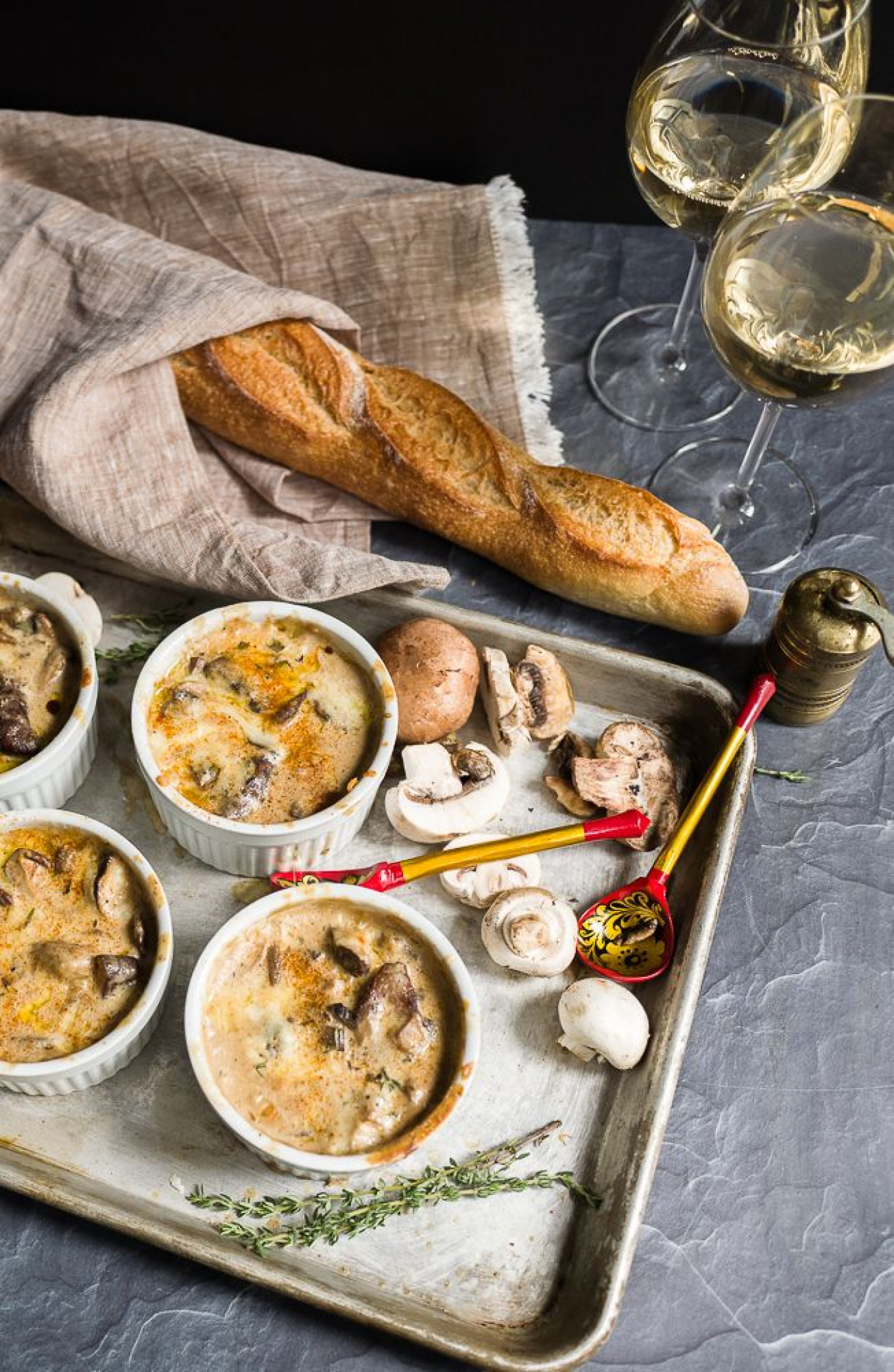
Both are reminders of my first job in Russia as a tour manager for large groups of American tourists, which streamed into the Former Soviet Union during the late 1980s and early 1990s. The Soviet Union might have fallen during those turbulent years, but its way of doing things limped along for another decade at least, under the aegis of the rigid immutable organizers of such tours on the ground, the state-run tourism behemoth, Intourist.
Say what you want about Intourist (and I have) they were robotically efficient. Anywhere you went in the Soviet Union — from Kaliningrad to Khabarovsk — all you had to do was walk into a hotel and no matter what time of the day or night, they would wait for you with exactly the number of beds you needed, and precisely (down the last cup of coffee) the breakfast you had contracted.
No money ever changed hands. The national guide, assigned by Intourist to shepherd the group around from place to place, kept an eagle eye on that side of things. And woe betide the group that wanted something outside the parameters of the set services.
This is where I came in. I was the buffer between the unyielding, Intourist way of doing things and the expectations of American tourists. I had to plead, cajole, and often bribe to fill the yawning gap between these two realities, and nowhere was that more true than with the kitchen staff with whom I danced the inscrutable minuet of bribery at the end of each tour to receive the very best Gala Farewell Dinner possible.
The Gala Farewell Dinner was the dramatic apogee of each tour of Russia, an expansive meal featuring buckets — barrels sometimes — of alcohol, a certain amount of balalaika music, and a rundown of classic Russian and Soviet dishes. It was cannily designed to obliterate any memory of all the lackluster repasts which had gone before it and float the guests towards their departure from the country on an alcohol-induced euphoric appreciation for Russia’s history, culture, and yes, even food.
The Gala Farewell Dinner rarely wandered off-piste to something experimental or non-traditional. It clung determinedly to the classics in the spirit that made Intourist a great state monopoly. It began with the zakuska overture, with just enough caviar to give everyone an appetite to buy a few jars from the waiters, and then it built to a triumphant crescendo of Chicken Kiev with a sweet coda of vanilla ice cream, all washed down with semi-sweet champagne and vodka and repeated renderings of “Lara’s Theme” by the balalaika ensemble.
What little wiggle room there was on the rigidly set menu ended up being a choice between an extra hot appetizer or more alcohol. I always chose Mushroom Julien, not only for its rich flavor but also for its dramatic presentation in individual cocottes on saucers, placed in front of each guest with the practiced flourish of a Soviet waiter who knows he’s delivering one of the stars of the evening.
Apart from its intrinsic association with Soviet glitzy social occasions, and the distinctive flourish of its presentation, Mushroom Julien’s chief appeal is its taste: a rich combination of mushrooms, butter, sour cream, and cheese. I’ve heard it described as “Mushroom Fondue” and while that is technically incorrect, it is a marvelously evocative comparison. The elegant way to consume Mushroom Julien is to spoon it from the cocotte in dainty bites that don’t muss up your party frock (particularly if you are being jostled at the busy theater buffet). The fun way to consume it is to dunk chunks of bread into the Julien and munch on them.
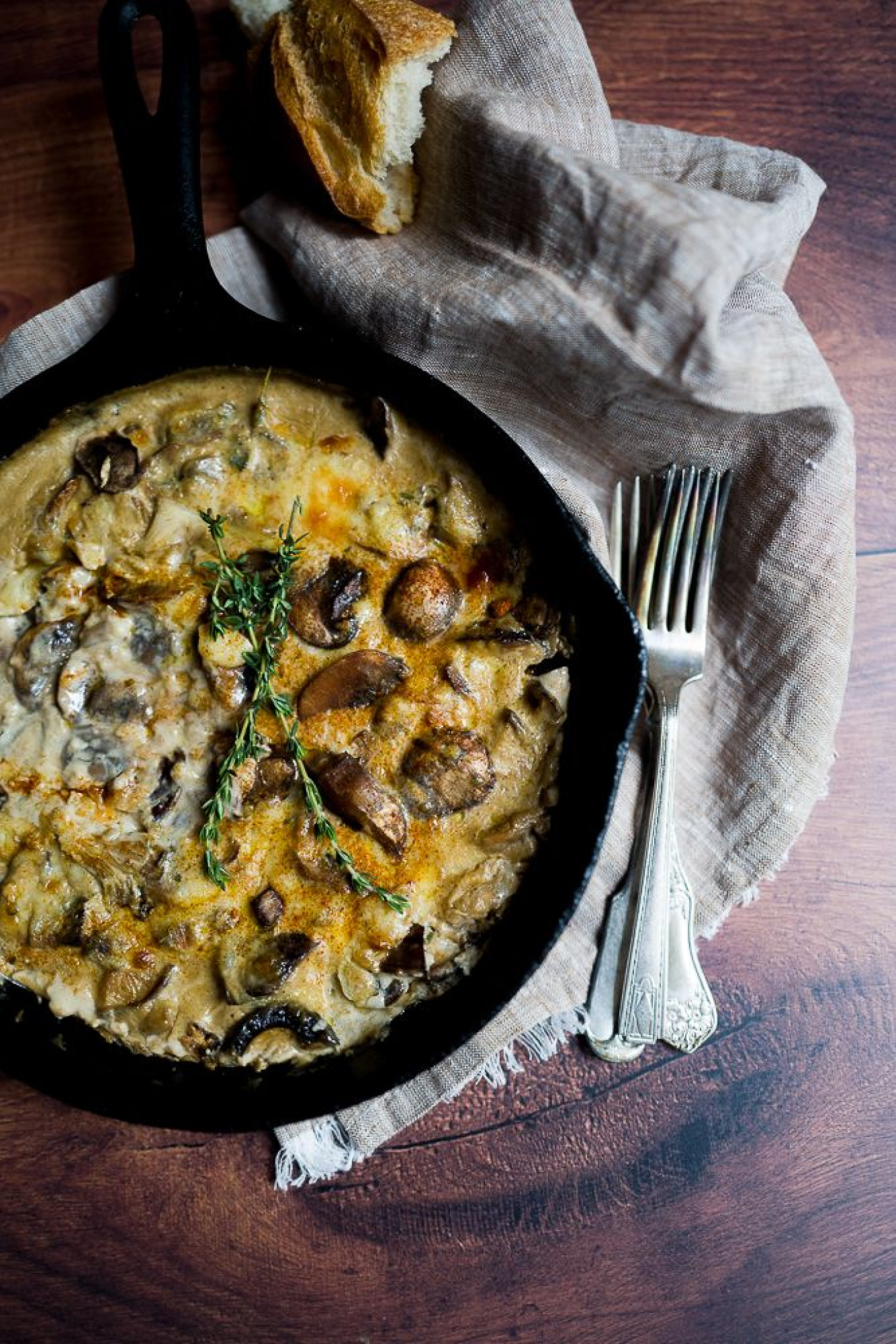
For all the fantastic meals I’ve enjoyed in Russian homes, I’ve never seen Mushroom Julien brought to the table. And that was true of my table too until a few years ago, when a friend gifted us with several baskets of foraged mushrooms, giving me the perfect opportunity to try to create this glitzy restaurant staple. And the conclusion I’ve come to is that Mushroom Julien deserves an upgrade in status from hot appetizer to main dish. And I hope this will encourage mushroom lovers to incorporate this incredibly satisfying creamy, umami dish into their weekly menu planning.
The recipe below takes a few liberties with the original concept but is as worthy of your fireside Sunday night dinner as it is any Gala Farewell Dinner. If you don’t own the requisite number of cocottes, not to worry — you can bring it golden brown and bubbling to the table in a plain old cast-iron skillet or a casserole dish. Combine it with a crusty baguette, a crispy salad, and a few glasses of wine, and voila! You just got your own fancy schmantsy glitzy evening — no bribes necessary.
“Lara’s Theme” is optional, but it works.
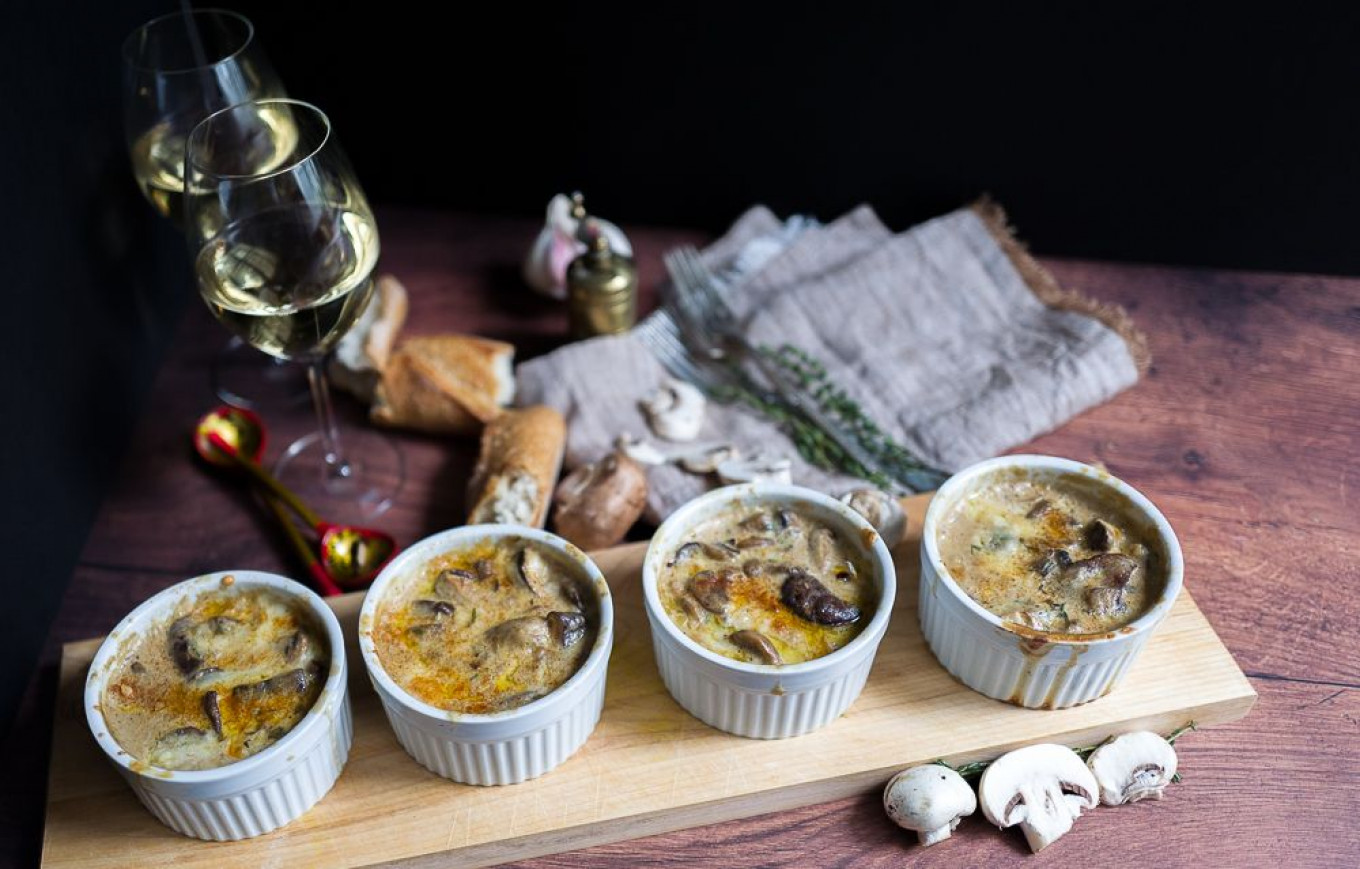
Mushroom Julien
Ingredients
- 2 lbs. (900 grams) fresh mushrooms (I love to use wild mushrooms, but get what you can: a combination of chanterelles, white mushrooms, Portabella will work very well), washed and cut into quarters or slices
- ½ lb. (230 grams) dried mushrooms
- ¼ cup (60 ml) Madeira
- 1 large shallot or 2 small ones, finely diced
- 2 cloves garlic, grated on a micro-plane
- Salt
- 4 Tbsp all-purpose flour
- 8 Tbsp butter, divided
- 1 cup (230 ml) whole milk
- ½ tsp nutmeg
- ½ tsp sweet paprika
- 1 dash Worcestershire sauce
- 1 cup (230 ml) sour cream
- 1 Tbsp chopped fresh sage
- 1 tsp chopped fresh thyme
- Several grinds of black pepper
- 2 cups (460 ml) grated cheese (use a combination of hard and semi-hard cheeses such as gruyère, emmenthal, fontina, gouda, or a nice sharp cheddar), divided.
Instructions
- Butter 6 ramekins or one casserole dish with 2 Tbsp butter.*
- Preheat the oven to 400ºF (220ºC).
Prepare the mushrooms
- Prepare the dried mushrooms by submerging them in a mixture of the Madeira and 2 cups (460 ml) boiling water. Let it sit for at least 30 minutes to completely rehydrate.
- Melt 2 Tbsp of butter in a heavy-bottomed skillet. When it is foaming, add the shallots and garlic and sauté until translucent (4-6 minutes).
- Add the fresh mushrooms and a good pinch of salt to the skillet and sauté over low heat until the mushrooms leach their liquid and reabsorb it again (8-12 minutes).
- Drain the rehydrated mushrooms (retain the soaking liquid!). Chop them roughly and add to the skillet, toss briefly to combine, then remove the skillet from the heat. Put one cup of the mushrooms in a smaller bowl and set both bowl and skillet aside to cool to room temperature.
Make the Béchamel sauce
- Melt 4 Tbsp of butter over low heat in a saucepan until it is foaming. Add the flour, nutmeg, and paprika and whisk to combine, then continue whisk gently for 1-2 minutes until the flour is completely cooked, emitting a nutty smell and taking on a rusty color.
- Slowly whisk in 1 cup of the mushroom soaking liquid and all the milk in ¼-cup (60 ml) increments, allowing the mixture to thicken after each addition. This is a slow process, so have patience and keep whisking gently until you have a thick mixture that coats the back of a wooden spoon. When finished, add the Worcestershire sauce, sage, and thyme. Taste and adjust seasoning with more salt and paprika if needed.
- Return the skillet with the mushroom and onion mixture to low heat. Add to it three quarters of the Béchamel sauce and all the sour cream and stir to combine. Continue to stir as you add one-third of the grated cheese in small increments. When the cheese is melted into the mixture, remove the skillet from the heat and let cool.
- Divide the mixture between the prepared ramekins or leave it in the skillet to cook as one dish. Whether you are using ramekins or a skillet, place them on a baking sheet lined with parchment paper to avoid any splatter. Spread the remaining Béchamel over the surface of the Julien, then divide the mushrooms you have set aside on top so they just poke up through the surface. Top each Julien with the remaining cheese. Give each surface a good grind of black pepper or dust with paprika. Bake until the mixture is bubbly and golden brown on top (10-15 minutes for ramekins and 18-20 for a full skillet).Let sit for 5 minutes before serving.
*Recipe Note
Mushroom Julien is traditionally served in individual ramekins or cocottes, but there is absolutely nothing in the playbook that says it needs to be. Cooked in one large, oven-proof cast-iron skillet or casserole Julien morphs effortlessly from a hot appetizer into a marvelous Sunday night dinner by the fire (or TV) that needs only a crusty baguette and a crisp salad to complete it.
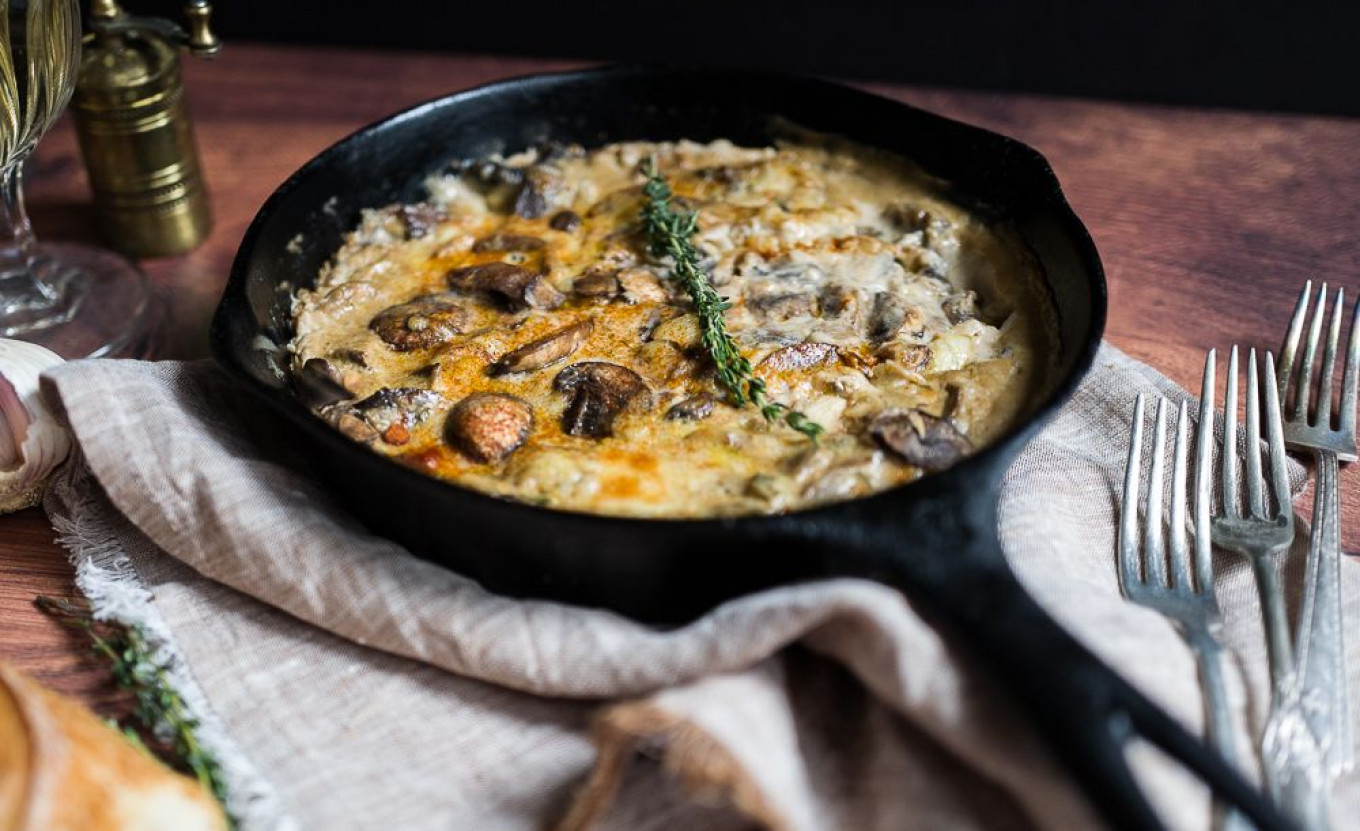
A Message from The Moscow Times:
Dear readers,
We are facing unprecedented challenges. Russia's Prosecutor General's Office has designated The Moscow Times as an "undesirable" organization, criminalizing our work and putting our staff at risk of prosecution. This follows our earlier unjust labeling as a "foreign agent."
These actions are direct attempts to silence independent journalism in Russia. The authorities claim our work "discredits the decisions of the Russian leadership." We see things differently: we strive to provide accurate, unbiased reporting on Russia.
We, the journalists of The Moscow Times, refuse to be silenced. But to continue our work, we need your help.
Your support, no matter how small, makes a world of difference. If you can, please support us monthly starting from just $2. It's quick to set up, and every contribution makes a significant impact.
By supporting The Moscow Times, you're defending open, independent journalism in the face of repression. Thank you for standing with us.
Remind me later.



